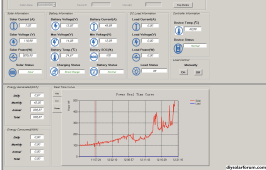frankz66
New Member
Hello everyone, my question is a beginner's question, so I ask you to clarify what I'm asking.
I currently use a string of 6 panels of 180 watts 12 v ( VOC 23.1 each ) for a total voc of 138.6 9 A .
The batteries are 4 agm of 12 v 110 amps in parallel for a total of 440 amps with 50% dod 2560 kwh .
My regulator is a pever 6415 AN which as I read from the manual supports a charge to the 12v batteries of about 750 watts. The manual reports a maximum of 1125 watts at 12v .
What I don't understand is, if at the moment I have 1080 watts with 138.6 volts of VOC but I only have 9 amps of delivery. As much as I have learned or rather I hope I have learned well, considering that my epever is a 60 amps and supports a maximum of 150 volts of VOC, I could say that I am using it little ... as if I bought another 6 panels identical to the first ones, I could create a 2s2p with 138 of VOC that would always remain so and have 18 Amps for a total of about 2485 kwh.
So as a beginner I wonder: if epever declares me max pv 1125 watts at 12 v, I would end up with twice as many watts because the amperes I'm using are still below the power threshold of 6415AN (60 AMPS).
So could I install a second string? Why what declares epever as pv 1125 watts at 12 v ???
Thank you for those who want to answer me.
Ps: If so to cover the 60 amps I could add other strings always in parallel to even reach 5 kwh.
Guys, I apologize right now if I've written some nonsense but I'm in my first experiences.
Thank you .
I currently use a string of 6 panels of 180 watts 12 v ( VOC 23.1 each ) for a total voc of 138.6 9 A .
The batteries are 4 agm of 12 v 110 amps in parallel for a total of 440 amps with 50% dod 2560 kwh .
My regulator is a pever 6415 AN which as I read from the manual supports a charge to the 12v batteries of about 750 watts. The manual reports a maximum of 1125 watts at 12v .
What I don't understand is, if at the moment I have 1080 watts with 138.6 volts of VOC but I only have 9 amps of delivery. As much as I have learned or rather I hope I have learned well, considering that my epever is a 60 amps and supports a maximum of 150 volts of VOC, I could say that I am using it little ... as if I bought another 6 panels identical to the first ones, I could create a 2s2p with 138 of VOC that would always remain so and have 18 Amps for a total of about 2485 kwh.
So as a beginner I wonder: if epever declares me max pv 1125 watts at 12 v, I would end up with twice as many watts because the amperes I'm using are still below the power threshold of 6415AN (60 AMPS).
So could I install a second string? Why what declares epever as pv 1125 watts at 12 v ???
Thank you for those who want to answer me.
Ps: If so to cover the 60 amps I could add other strings always in parallel to even reach 5 kwh.
Guys, I apologize right now if I've written some nonsense but I'm in my first experiences.
Thank you .



